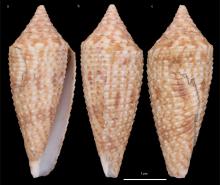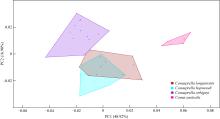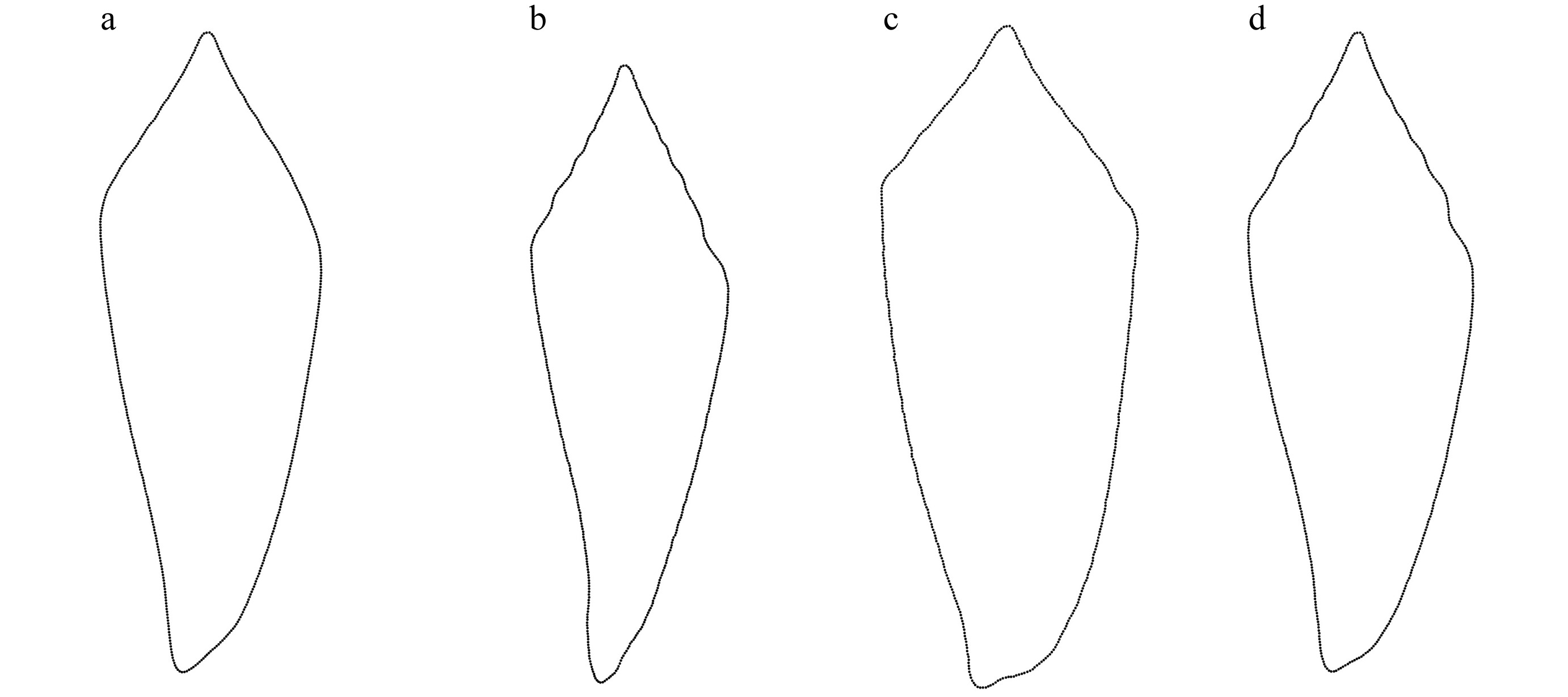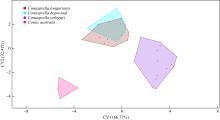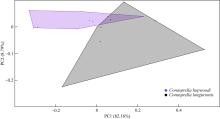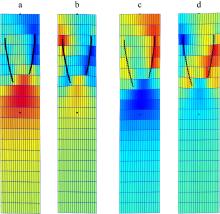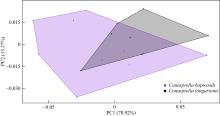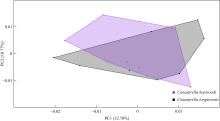热带海洋学报 ›› 2025, Vol. 44 ›› Issue (4): 145-165.doi: 10.11978/2024165
中国海域双锥芋螺属Conasprella (Gastropoda, Conidae)近似种的比较研究
何晨1,2( ), 王佳宁1,2, 陈志云1(
), 王佳宁1,2, 陈志云1( ), 谭烨辉1,2
), 谭烨辉1,2
- 1.中国科学院南海海洋研究所, 南海海洋生物标本馆, 广东省应用海洋生物学重点实验室, 广东 广州 510301
2.中国科学院大学, 北京 100049
-
收稿日期:2024-08-28修回日期:2024-09-18出版日期:2025-07-10发布日期:2025-07-31 -
通讯作者:陈志云 -
作者简介:何晨(1999—), 男, 广东省佛山市人, 硕士研究生, 研究方向: 海洋贝类分类学。email: tingsaki@outlook.com
-
基金资助:中国科学院分类学科学家岗位项目(CAS-TAX-24-043); 国家动物标本资源库
Comparative study on Conasprella cones species in Chinese waters
HE Chen1,2( ), WANG Jianing1,2, CHEN Zhiyun1(
), WANG Jianing1,2, CHEN Zhiyun1( ), TAN Yehui1,2
), TAN Yehui1,2
- 1. Marine Biodiversity Collection of South China Sea, Guangdong Provincial Key Laboratory of Applied Marine Biology, South China Sea Institute of Oceanology, Chinese Academy of Sciences, Guangzhou 510301, China
2. University of Chinese Academy of Sciences, Beijing 100049, China
-
Received:2024-08-28Revised:2024-09-18Online:2025-07-10Published:2025-07-31 -
Contact:CHEN Zhiyun -
Supported by:Taxonomist Project, Chinese Academy of Sciences(CAS-TAX-24-043); National Animal Collection Resource Center, China
摘要:
本研究比较了双锥芋螺属Conasprella的欧氏芋螺Conasprella orbignyi (Audouin, 1831)与其近似种龙王芋螺Conasprella ichinoseana (Kuroda, 1956)、昏芋螺Conasprella comatose (Pilsbry, 1904)、郝伍德芋螺Conasprella hopwoodi (Tomlin, 1936)、柳斑芋螺Conasprella longurionis (Kiener, 1847)和南方芋螺Conus australis Holten, 1802之间的形态差异, 报道了郝伍德芋螺和柳斑芋螺在国内的新分布地点。通过几何形态学对这些易混淆种进行分析, 对欧氏芋螺、柳斑芋螺、郝伍德芋螺和南方芋螺外轮廓的几何形态数据进行主成分分析, 揭示了这4种芋螺在外轮廓上的差异; 典型变量分析的结果进一步显示, 外轮廓的几何形态对欧氏芋螺和南方芋螺有良好的判别效果, 对南方芋螺和欧氏芋螺的判别正确率分别为100.00%和92.86%。对柳斑芋螺和郝伍德芋螺的体螺层螺肋几何形态进行主成分分析, 发现前者螺旋部更高、体螺层更宽、基部距离更短、体螺层各个螺肋之间距离更宽, 而后者螺旋部低、体螺层更窄、基部距离更长、体螺层上各个螺肋之间距离更窄; 典型变量分析的进一步结果显示体螺层的地标点对极易混淆的柳斑芋螺和郝伍德芋螺具有良好的判别效果, 正确率分别是87.50%和88.89%。对柳斑芋螺和郝伍德芋螺的螺旋部几何形态进行主成分分析, 二者未明显分离; 典型变量分析的进一步结果显示对二者判别与基于体螺层螺肋几何形态的判别结果一致。对柳斑芋螺和郝伍德芋螺的壳口几何形态进行主成分分析, 二者未明显分离; 典型变量分析的进一步结果显示对二者判别正确率分别是62.50%和77.78%, 壳口并不是区分鉴定柳斑芋螺和郝伍德芋螺这一对易混淆种的有效依据。本研究为芋螺近似种和易混淆种的区分提供了新的鉴别方法。
中图分类号:
- P735
引用本文
何晨, 王佳宁, 陈志云, 谭烨辉. 中国海域双锥芋螺属Conasprella (Gastropoda, Conidae)近似种的比较研究[J]. 热带海洋学报, 2025, 44(4): 145-165.
HE Chen, WANG Jianing, CHEN Zhiyun, TAN Yehui. Comparative study on Conasprella cones species in Chinese waters[J]. Journal of Tropical Oceanography, 2025, 44(4): 145-165.
表1
芋螺研究材料"
| 物种 | 标本号 | 数量 | 采集地 | 采集人 | 采集时间 |
|---|---|---|---|---|---|
| 南方芋螺 Conus australis | SCSMBC006351 | 1 | 汕尾遮浪 | 林碧萍 | 1980-12-19 |
| 南方芋螺 Conus australis | SCSMBC008637 | 2 | 南海北部 | 晏磊 | 2016-09-09 |
| 南方芋螺 Conus australis | SCSMBC008638 | 1 | 东海南部拖网 | 王洋 | 2017-12 |
| 南方芋螺 Conus australis | SCSMBC008639 | 1 | 东海南部拖网 | 王洋 | 2017-12 |
| 昏芋螺 Conus comatosa | DH24070909 | 1 | 浙江东海120m水深拖网 | 何径 | 2010 |
| 昏芋螺 Conus comatosa | DH24070913 | 1 | 浙江东海120m水深拖网 | 何径 | 2010 |
| 昏芋螺 Conus comatosa | DH24070914 | 1 | 浙江东海120m水深拖网 | 何径 | 2010 |
| 龙王芋螺Conasprella ichinoseana | SCMSBC008640 | 1 | 东海南部150~180m泥沙海底拖网 | 南海所 | 2015-04 |
| 欧氏芋螺 Conasprella orbignyi | SCMSBC006413 | 1 | 汕尾遮浪 | 林碧萍 | 1980-12-19 |
| 欧氏芋螺 Conasprella orbignyi | SCMSBC008645 | 1 | 东海南部150~180m泥沙海底拖网 | 王洋 | 2018-03 |
| 欧氏芋螺 Conasprella orbignyi | SCMSBC008646 | 1 | 东海南部150~180m泥沙海底拖网 | 王洋 | 2018-03 |
| 欧氏芋螺 Conasprella orbignyi | SCMSBC008647 | 1 | 东海南部150~180m泥沙海底拖网 | 王洋 | 2018-03 |
| 欧氏芋螺 Conasprella orbignyi | DH24070901 | 1 | 东海南部海底拖网 | 何径 | 2010s |
| 欧氏芋螺 Conasprella orbignyi | DH24070902 | 1 | 东海南部海底拖网 | 何径 | 2010s |
| 欧氏芋螺 Conasprella orbignyi | DH24070903 | 1 | 东海南部海底拖网 | 何径 | 2010s |
| 欧氏芋螺 Conasprella orbignyi | DH24070904 | 1 | 东海南部海底拖网 | 何径 | 2010s |
| 欧氏芋螺 Conasprella orbignyi | DH24070905 | 1 | 东海南部海底拖网 | 何径 | 2010s |
| 欧氏芋螺 Conasprella orbignyi | DH24070906 | 1 | 东海南部海底拖网 | 何径 | 2010s |
| 欧氏芋螺 Conasprella orbignyi | DH24070907 | 1 | 东海南部海底拖网 | 何径 | 2010s |
| 欧氏芋螺 Conasprella orbignyi | DH24070908 | 1 | 东海南部海底拖网 | 何径 | 2010s |
| 欧氏芋螺 Conasprella orbignyi | DH24070909 | 1 | 东海南部海底拖网 | 何径 | 2010s |
| 欧氏芋螺 Conasprella orbignyi | DH24070911 | 1 | 东海南部海底拖网 | 何径 | 2010s |
| 欧氏芋螺 Conasprella orbignyi | DH24070912 | 1 | 东海南部海底拖网 | 何径 | 2010s |
| 郝伍德芋螺Conasprella hopwoodi | SCSMBC006302 | 1 | 汕尾遮浪 | 南海海洋研究所 | 1980-12-19 |
| 郝伍德芋螺Conasprella hopwoodi | SCSMBC006314 | 1 | 汕尾遮浪 | 南海海洋研究所 | 1980-12-19 |
| 郝伍德芋螺Conasprella hopwoodi | SCSMBC006315 | 1 | 汕尾遮浪 | 南海海洋研究所 | 1980-12-19 |
| 郝伍德芋螺Conasprella hopwoodi | SCSMBC006323 | 1 | 汕尾遮浪 | 南海海洋研究所 | 1980-12-19 |
| 郝伍德芋螺Conasprella hopwoodi | SCSMBC006325 | 1 | 汕尾遮浪 | 南海海洋研究所 | 1980-12-19 |
| 郝伍德芋螺Conasprella hopwoodi | SCSMBC006326 | 1 | 汕尾遮浪 | 南海海洋研究所 | 1980-12-19 |
| 郝伍德芋螺Conasprella hopwoodi | SCSMBC006327 | 1 | 汕尾遮浪 | 南海海洋研究所 | 1980-12-19 |
| 郝伍德芋螺Conasprella hopwoodi | SCSMBC006331 | 1 | 汕尾遮浪 | 南海海洋研究所 | 1980-12-19 |
| 郝伍德芋螺Conasprella hopwoodi | SCSMBC006367 | 1 | 汕尾遮浪 | 南海海洋研究所 | 1980-12-19 |
| 郝伍德芋螺Conasprella hopwoodi | SCSMBC006368 | 1 | 汕尾遮浪 | 南海海洋研究所 | 1980-12-19 |
| 郝伍德芋螺Conasprella hopwoodi | SCSMBC006369 | 1 | 汕尾遮浪 | 南海海洋研究所 | 1980-12-19 |
| 柳斑芋螺 Conasprella longurionis | SCMSBC006334 | 1 | 汕尾遮浪 | 南海海洋研究所 | 1980-12-19 |
| 柳斑芋螺 Conasprella longurionis | SCMSBC006335 | 1 | 汕尾遮浪 | 南海海洋研究所 | 1980-12-19 |
| 柳斑芋螺 Conasprella longurionis | SCMSBC006343 | 1 | 汕尾遮浪 | 南海海洋研究所 | 1980-12-19 |
| 柳斑芋螺 Conasprella longurionis | SCMSBC006348 | 1 | 汕尾遮浪 | 南海海洋研究所 | 1980-12-19 |
| 柳斑芋螺 Conasprella longurionis | SCMSBC006354 | 1 | 汕尾遮浪 | 南海海洋研究所 | 1980-12-19 |
| 柳斑芋螺 Conasprella longurionis | SCMSBC006355 | 1 | 汕尾遮浪 | 南海海洋研究所 | 1980-12-19 |
| 柳斑芋螺 Conasprella longurionis | SCMSBC006359 | 1 | 汕尾遮浪 | 南海海洋研究所 | 1980-12-19 |
| 柳斑芋螺 Conasprella longurionis | SCMSBC006360 | 1 | 汕尾遮浪 | 南海海洋研究所 | 1980-12-19 |
| 柳斑芋螺 Conasprella longurionis | SCMSBC006361 | 1 | 汕尾遮浪 | 南海海洋研究所 | 1980-12-19 |
| 柳斑芋螺 Conasprella longurionis | SCMSBC006362 | 1 | 汕尾遮浪 | 南海海洋研究所 | 1980-12-19 |
| 柳斑芋螺 Conasprella longurionis | SCMSBC006364 | 1 | 汕尾遮浪 | 南海海洋研究所 | 1980-12-19 |
| [1] |
白明, 杨星科, 李静, 等, 2014. 几何形态学: 关于形态定量比较的科学计算工具[J]. 科学通报, 59(10): 887-894.
|
|
|
|
| [2] |
蔡英亚, 刘桂茂, 1989. 广东西部沿海的贝类[J]. 湛江水产学院学报, 9(1-2): 57-78, 87.
|
|
|
|
| [3] |
陈新军, 方舟, 陈洋洋, 等, 2017. 几何形态测量学在水生生物中的应用[M]. 北京: 科学出版社.
|
|
|
|
| [4] |
陈志云, 连喜平, 谭烨辉, 2019. 南海芋螺科一新记录(腹足纲,芋螺科)[J]. 热带海洋学报, 38(4): 59-63.
doi: 10.11978/2018109 |
|
|
|
| [5] |
陈志云, 谭烨辉, 连喜平, 2016. 中国海芋螺属一新记录(腹足纲, 芋螺科)[J]. 热带海洋学报, 35(3): 99-100.
doi: 10.11978/2015089 |
|
|
|
| [6] |
葛德燕, 夏霖, 吕雪霏, 等, 2012. 几何形态学方法及其在动物发育与系统进化研究中的应用[J]. 动物分类学报, 37(2): 296-304.
|
|
|
|
| [7] |
金武, 马学艳, 彭刚, 等, 2024. 梨形环棱螺11个地理种群的几何形态学分析[J]. 中国农学通报, 40(2): 159-164.
doi: 10.11924/j.issn.1000-6850.casb2023-0093 |
|
|
|
| [8] |
何晨, 陈志云, 谭烨辉, 2024. 黑芋螺和其近似种的特征比较[J]. 热带生物学报, 15(3): 349-353.
|
|
|
|
| [9] |
李凤兰, 1995. 中国近海芋螺科的研究Ⅱ[J]. 海洋科学集刊, 36: 245-266, 319-322.
|
|
|
|
| [10] |
李凤兰, 林民玉, 2016. 中国动物志无脊椎动物 (第五十五卷) 软体动物门腹足纲芋螺科[M]. 北京: 科学出版社: 11-286, pls. 1-4, figs. 1-168
|
|
|
|
| [11] |
李浩楠, 毛楷林, 熊洋, 等, 2020. α-芋螺毒素LvIA特定氨基酸的突变对其活性的影响[J]. 中国海洋药物, 39(6): 45-51.
|
|
|
|
| [12] |
李晓丹, 油珅, 罗素兰, 等, 2020. α-芋螺毒素TxIB抗药物依赖的初步探索[J]. 中国海洋药物, 39(6): 39-44.
|
|
|
|
| [13] |
罗雪, 赵元龙, 陈圣光, 等, 2023. 贵州剑河寒武系苗岭统凯里组太阳女神螺类几何形态学研究[J]. 古生物学报, 62(1): 78-97.
|
|
|
|
| [14] |
舒予, 史令, 郝振林, 等, 2022. 几何形态学对8种扇贝的形态分类的应用[J]. 海洋科学, 46(6): 61-69.
|
|
|
|
| [15] |
张素萍, 2008. 中国海洋贝类图鉴[M]. 北京: 海洋出版社 (in Chinese).
|
| [16] |
|
| [17] |
|
| [18] |
|
| [19] |
|
| [20] |
|
| [21] |
|
| [22] |
|
| [23] |
|
| [24] |
|
| [25] |
|
| [26] |
|
| [27] |
|
| [28] |
|
| [29] |
|
| [30] |
doi: 10.1016/j.ympev.2010.11.020 pmid: 21147238 |
| [31] |
|
| [32] |
|
| [33] |
|
| [34] |
|
| [35] |
|
| [36] |
|
| [37] |
|
| [38] |
|
| [39] |
MOLLUSCABASE, 2019. MolluscaBase. ConasprellaThiele, 1929 [DB/OL]//World Register of Marine Species. (2019-01-11) [2024-05-25]. https://www.marinespecies.org/aphia.php?p=taxdetails&id=428971
|
| [40] |
MOLLUSCABASE, 2022. MolluscaBase. Conidae J. Fleming, 1822 [DB/OL]//World Register of Marine Species. (2022-03-26) [2024-05-25]. https://www.marinespecies.org/aphia.php?p=taxdetails&id=14107
|
| [41] |
|
| [42] |
|
| [43] |
|
| [44] |
|
| [45] |
|
| [46] |
|
| [47] |
doi: 10.1016/j.ympev.2014.05.023 pmid: 24878223 |
| [48] |
|
| [49] |
pmid: 26300576 |
| [50] |
pmid: 21712968 |
| [51] |
|
| [52] |
|
| [53] |
doi: 10.11646/zootaxa.4441.3.3 pmid: 30313996 |
| [54] |
|
|
|
|
| [55] |
|
| [56] |
|
| [57] |
|
| [58] |
|
| [59] |
doi: 10.1093/sysbio/syt002 pmid: 23325808 |
| [60] |
|
| [61] |
|
| [62] |
|
| [63] |
|
| [64] |
|
| [65] |
|
| [66] |
|
| [67] |
|
| [68] |
|
| [69] |
|
| [1] | 何晨, 陈志云, 谭烨辉. 中国南沙群岛新腹足目二新记录种(软体动物门, 腹足纲)*[J]. 热带海洋学报, 2024, 43(6): 140-144. |
| [2] | 霍嘉欣, 李颖心, 宋严, 朱晴, 周伟华, 袁翔城, 黄晖, 刘胜. 木珊瑚科Cladopsammia gracilis和Rhizopsammia wettsteini 线粒体全基因组比较与系统进化分析*[J]. 热带海洋学报, 2024, 43(3): 22-30. |
| [3] | 陈志云, 郭翔, 刘毅, 尉鹏, 张素萍. 厦门近海尖梭螺属(软体动物门, 腹足纲, 梭螺科)一新记录种[J]. 热带海洋学报, 2022, 41(2): 189-192. |
| [4] | 陈志云,连喜平,谭烨辉. 南海芋螺科一新记录种(软体动物门, 腹足纲, 新腹足目)[J]. 热带海洋学报, 2019, 38(4): 59-63. |
| [5] | 董焕嫦, 黄春秀, 徐国双, 李扬. 中国沿海尖刺拟菱形藻的种下分类学研究*[J]. 热带海洋学报, 2018, 37(1): 12-19. |
| [6] | 陈志云, 谭烨辉, 连喜平. 中国海芋螺属一新记录(腹足纲, 芋螺科)[J]. 热带海洋学报, 2016, 35(3): 99-100. |
| [7] | 陈志云, 谭烨辉, 连喜平. 黑线蜑螺的种名修订和特征鉴别[J]. 热带海洋学报, 2015, 34(4): 74-76. |
|
||














